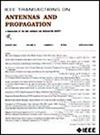Beam-Switchable Digital Conformal Array With Metasurface Phase Compensation
IF 4.6
1区 计算机科学
Q1 ENGINEERING, ELECTRICAL & ELECTRONIC
引用次数: 0
Abstract
This article presents a novel digitally reconfigurable conformal array using the multimode control and metasurface phase compensation. The digital conformal array consists of a 1-bit multimode radiator, metasurfaces, and switch designs. By manipulating the field distributions of the transmission line (TL), a miniaturized multimode radiator is explored. Next, a low-cost 1-bit planar digital array without any feeding networks is proposed by coding the 0°/180° phase states of each mode/element. To match the circular/cylindrical/spherical scenarios, the planar digital array evolves into a conformal format. Here, to further lower the complexity and cost, the spatial phase difference of the digital conformal array is cleverly compensated by utilizing a metasurface layer rather than conventional phase-delay-line designs. By controlling the 1-bit phase states of each element, the radiation aperture of the digital conformal array is represented as a “0/1” binary sequence, which leads to an RIS-like multibeam switching capability. Moreover, by introducing the initial phase, a new 1-bit digital array with a single-beam steering capability is extended to further explore its application potential. To validate the concept, a four-element 1-bit digital conformal array was fabricated and measured. The digital conformal array could achieve a −10 dB impedance bandwidth of 4.74–5.12 GHz (7.7%) and a peak gain of 11.0 dBi, which makes it a good candidate for intelligent wireless communication and detection applications.求助全文
约1分钟内获得全文
求助全文
来源期刊
CiteScore
10.40
自引率
28.10%
发文量
968
审稿时长
4.7 months
期刊介绍:
IEEE Transactions on Antennas and Propagation includes theoretical and experimental advances in antennas, including design and development, and in the propagation of electromagnetic waves, including scattering, diffraction, and interaction with continuous media; and applications pertaining to antennas and propagation, such as remote sensing, applied optics, and millimeter and submillimeter wave techniques

 求助内容:
求助内容: 应助结果提醒方式:
应助结果提醒方式:


